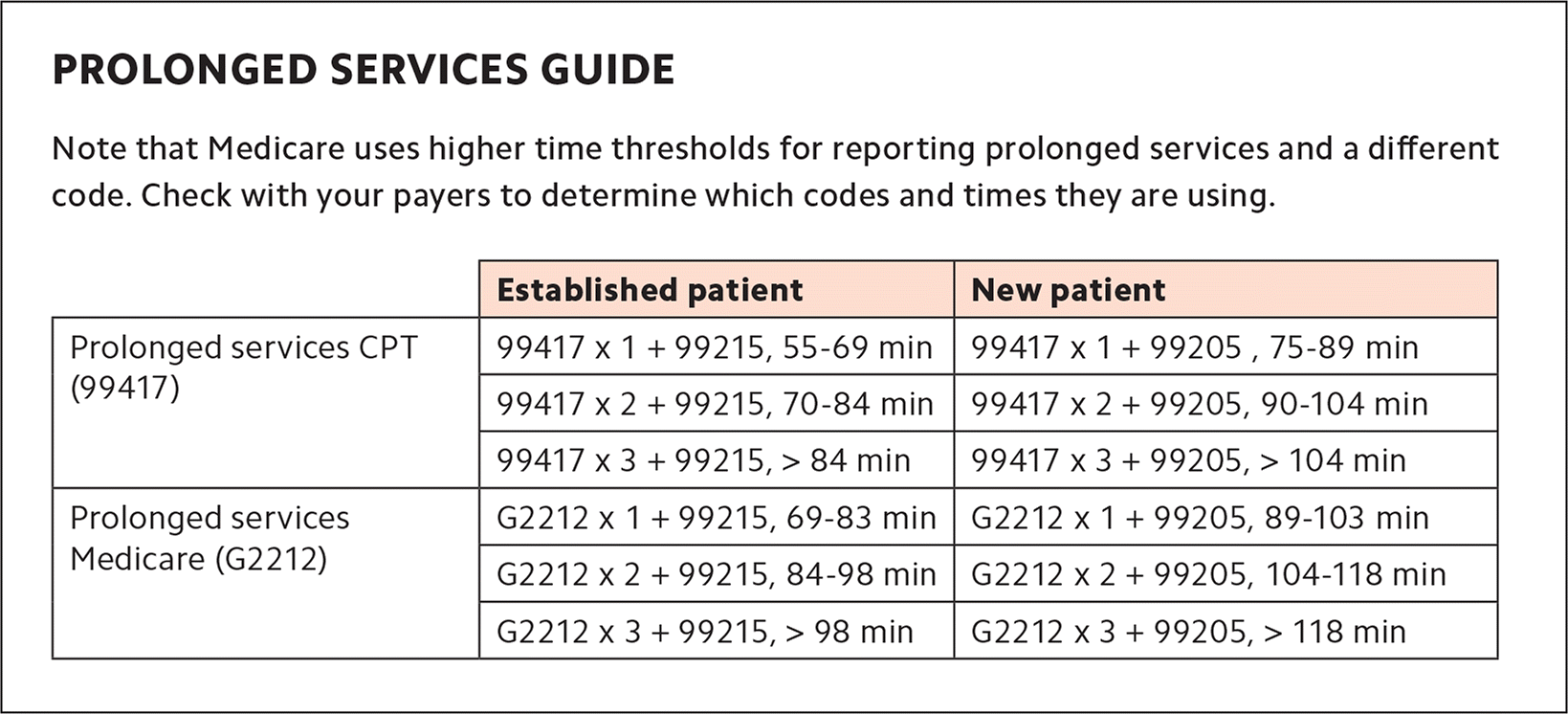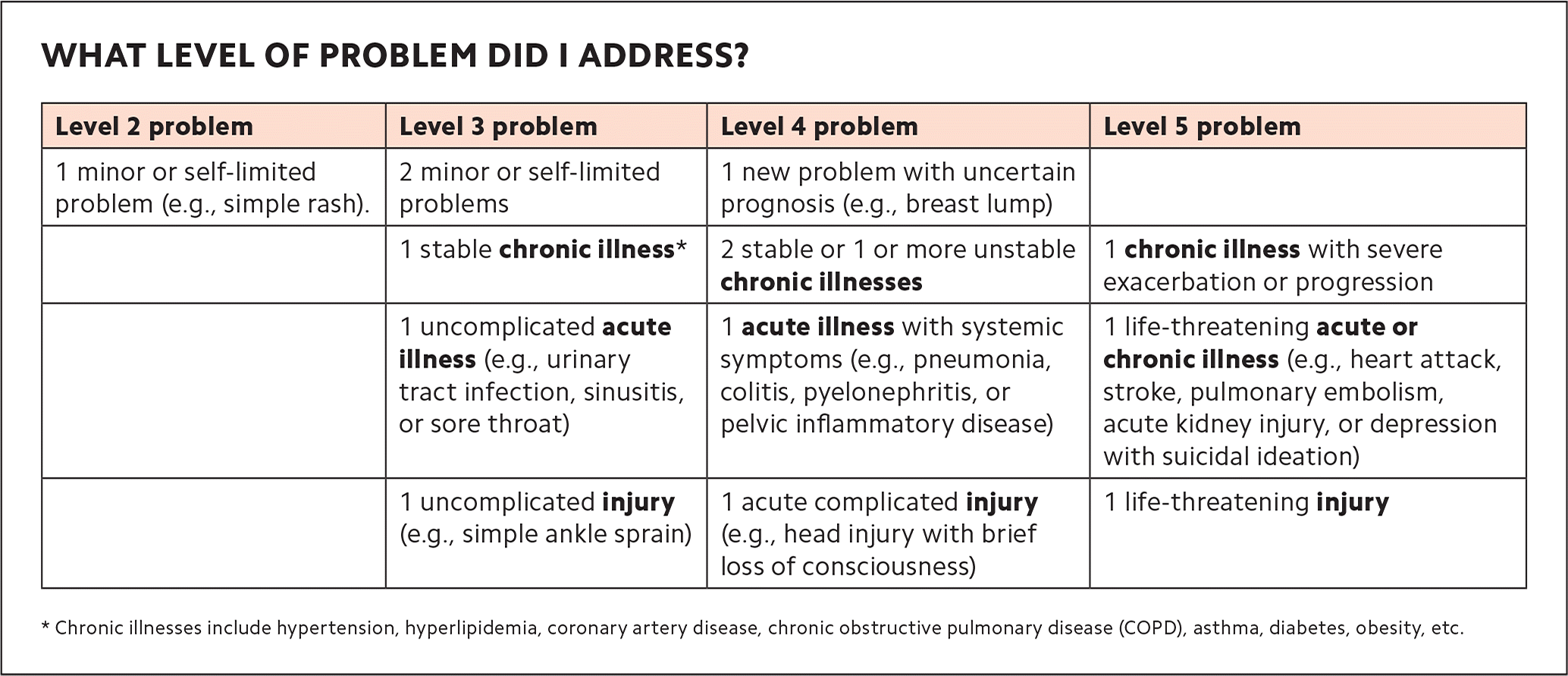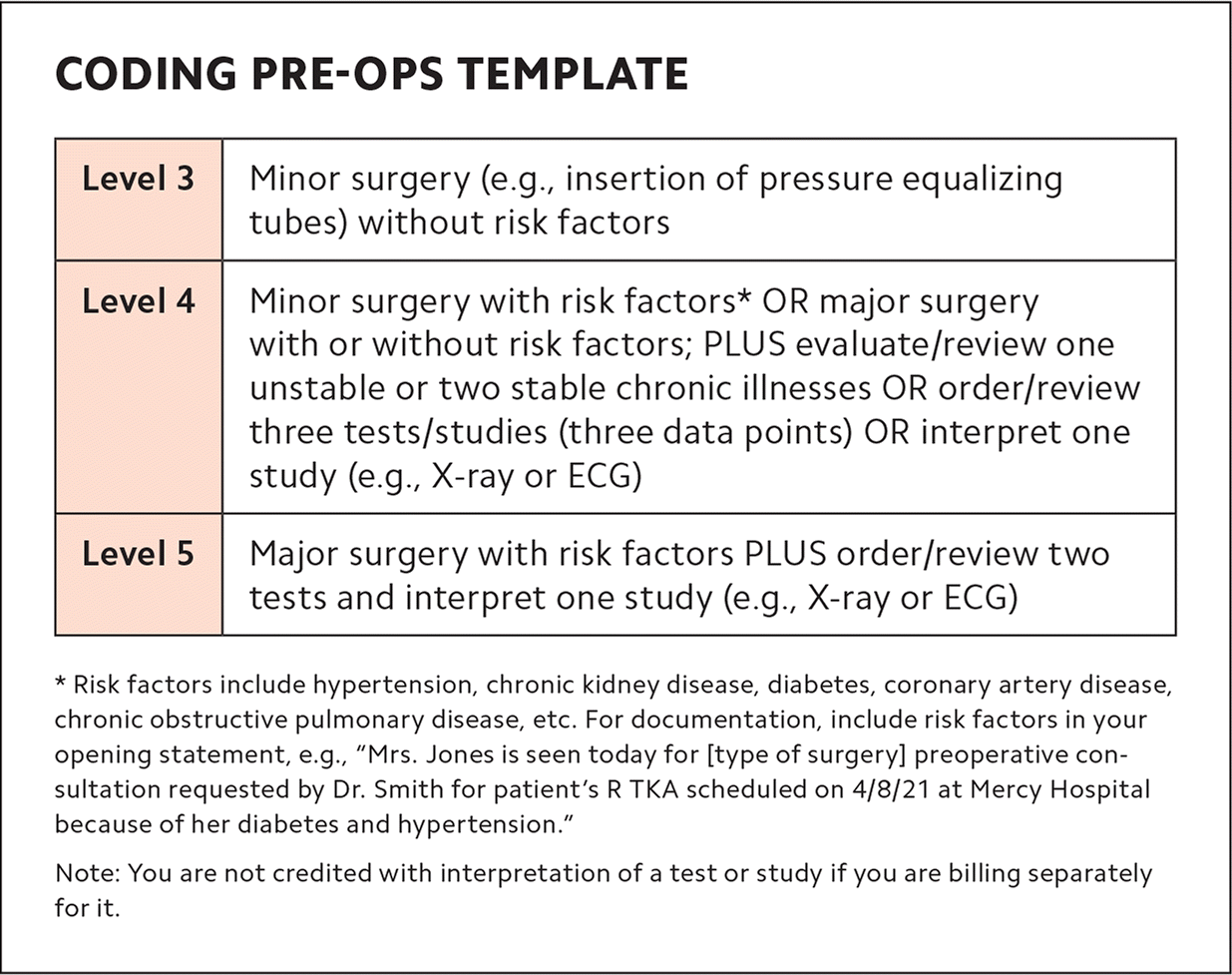
Follow these four steps to code quickly and accurately, while reducing the need to count up data points.
Fam Pract Manag. 2021;28(4):21-26
Author disclosure: no relevant financial affiliations.

The new rules for coding evaluation and management (E/M) office visits are a big improvement but still a lot to digest.1,2 To ease the transition, previous FPM articles have laid out the new American Medical Association/CPT medical decision making guide3 and introduced doctor–friendly coding templates (see “Countdown to the E/M Coding Changes,” FPM, September/October 2020), explained how to quickly identify level 4 office visits (see “Coding Level 4 Visits Using the New E/M Guidelines,” FPM, January/February 2021), and applied the new guidelines to common visit types (see “The 2021 Office Visit Coding Changes: Putting the Pieces Together,” FPM, November/December 2020).
After several months of using the new coding rules, it has become clear that the most difficult chore of coding office visits now is assessing data to determine the level of medical decision making (MDM). Analyzing each note for data points can be time-consuming and sometimes confusing.
That being the case, it's important to understand when you can avoid using data for coding, and when you can't. I've developed a four-step process for this (see “A step-by-step timesaver”).
The goal of this article is to clarify the new coding rules and terminology and to explain this step-by-step approach to help clinicians code office visits more quickly, confidently, and correctly.
KEY POINTS
The new evaluation and management office visit coding rules have simplified many things but are still a lot to digest, especially when it comes to counting data.
There are different levels of data and different categories within each level, which can make using data to calculate the visit level time-consuming and confusing.
By calculating total time, and then moving on to assessing problems and prescription drug management, most visits can be optimally coded without dealing with data at all.
OFFICE VISIT CODING RULES AND TERMINOLOGY
To make full use of the step-by-step process, we have to first understand the new rules, as well as coding terminology. Here is a brief summary.
Medically appropriate. Physicians and other qualified health care professionals may now solely use either total time or MDM to determine the level of service of an office visit. That means the “history” and “physical exam” components are no longer needed for code selection, which simplifies things. But your patient note must still contain a “medically appropriate” history and physical. So continue to document what is needed for good medical care.
New patient. A new patient is a patient who has not been seen by you or one of your partners in the same medical specialty and the same group practice within the past three years.
Total time and prolonged services. Total time includes all the time you spend on a visit on the day of the encounter (before midnight). It includes your time before the visit reviewing the chart, your face-to-face time with the patient, and the time you spend after the visit finishing documentation, ordering or reviewing studies, refilling medications, making phone calls related to the visit, etc. It does not include your time spent performing separately billed services such as wellness visits or procedures. Total time visit level thresholds differ for new patients vs. established patients. (See the total times in “The Rosetta Stone four-step template for coding office visits.”)
The prolonged services code comes into play when total time exceeds the limits set for level 5 visits by at least 15 minutes.

| Established patient | New patient | |
|---|---|---|
| Prolonged services CPT (99417) | 99417 x 1 + 99215, 55–69 min | 99417 x 1 + 99205, 75–89 min |
| 99417 x 2 + 99215, 70–84 min | 99417 x 2 + 99205, 90–104 min | |
| 99417 x 3 + 99215, > 84 min | 99417 x 3 + 99205, > 104 min | |
| Prolonged services Medicare (G2212) | G2212 x 1 + 99215, 69–83 min | G2212 x 1 + 99205, 89–103 min |
| G2212 x 2 + 99215, 84–98 min | G2212 x 2 + 99205, 104–118 min | |
| G2212 x 3 + 99215, > 98 min | G2212 x 3 + 99205, > 118 min |
Medical decision making. MDM is made up of three components: problems, data, and risk. Each component has different levels, which correspond to levels of service (low/limited = level 3, moderate = level 4, and high/extensive = level 5). The highest level reached by at least two out of the three components determines the correct code for the level of service. MDM criteria is the same for new and established patients.
Problems addressed. This includes only the problems you address at that specific patient visit. It does not include all the patient's diagnoses and does not include problems that are exclusively managed by another clinician. Problems addressed are separated into low-complexity problems (level 3), moderate-complexity problems (level 4), and high-complexity problems (level 5). To code correctly, you need to know the coding value of the problems you address. It is helpful to think of problems in terms of levels of service (e.g., a sinus infection is usually a level 3 problem, and pneumonia or uncontrolled diabetes are usually level 4 problems).
The simplest way to summarize problems is this: Life-threatening problems are level 5; acute or chronic illnesses or injuries are level 3 or 4 depending on how many there are, how stable they are, and how complex they are; and if there's just one minor problem, it's level 2.
(For more specifics see “What level of problem did I address?”)

| Level 2 problem | Level 3 problem | Level 4 problem | Level 5 problem |
|---|---|---|---|
| 1 minor or self-limited problem (e.g., simple rash). | 2 minor or self-limited problems | 1 new problem with uncertain prognosis (e.g., breast lump) | |
| 1 stable chronic illness* | 2 stable or 1 or more unstable chronic illnesses | 1 chronic illness with severe exacerbation or progression | |
| 1 uncomplicated acute illness (e.g., urinary tract infection, sinusitis, or sore throat) | 1 acute illness with systemic symptoms (e.g., pneumonia, colitis, pyelonephritis, or pelvic inflammatory disease) | 1 life-threatening acute or chronic illness (e.g., heart attack, stroke, pulmonary embolism, acute kidney injury, or depression with suicidal ideation) | |
| 1 uncomplicated injury (e.g., simple ankle sprain) | 1 acute complicated injury (e.g., head injury with brief loss of consciousness) | 1 life-threatening injury |
Risk. Risk is also separated into “low” (level 3), “moderate” (level 4), and “high” (level 5) categories.
Level 3 risk includes the use of over-the-counter (OTC) medications.
Level 4 risk includes the following:
Prescription drug management: starting, stopping, modifying, refilling, or deciding to continue a prescription medication (and documenting your thought process),
Social determinants of health that limit diagnosis or treatment (this is when patients' lack of finances, insurance, food, housing, etc., affects your ability to diagnose, manage, and care for them as you normally would).
Level 5 risk includes the following:
Decisions about hospitalization,
Decisions about emergency major surgery,
Drug therapy that requires intensive toxicity monitoring,
Decisions to not resuscitate or to de-escalate care because of poor prognosis.
Data analyzed. For purposes of MDM, data is characterized as “limited” (level 3 data), “moderate” (level 4 data), or “extensive” (level 5 data). But each level of data is further split into Categories 1, 2, and 3. This can make calculating data complicated, confusing, and time-consuming. Here are the data components and terms you need to know.
Category 1 data includes the following:
The ordering or reviewing of each unique test, i.e., a single lab test, panel, X-ray, electrocardiogram (ECG), or other study.
Ordering and reviewing the same lab test or study is worth one point, not two; a lab panel (e.g., complete blood count or comprehensive metabolic panel) is worth one point,
Reviewing a pertinent test or study done in the past at your own facility or another facility,
Reviewing prior external notes from each unique source, including records from a clinician in a different specialty or from a different group practice or facility as well as each separate health organization (e.g., reviewing three notes from the Mayo Clinic is worth one point, not three, but reviewing one note from Mayo and one from Johns Hopkins is worth a total of two points),
Using an independent historian, which means obtaining a history from someone other than the patient, such as a parent, spouse, or group home staff member. (This is included in Category 2 for level 3 data, but falls into Category 1 for level 4 and 5 data.)
Category 2 data includes the following:
Using an independent historian (for level 3 data only),
Independent interpretation of tests, which is your evaluation or reading of an X-ray, ECG, or other study (e.g., “I personally reviewed the X-ray and it shows …”) and can include your personal evaluation of a pertinent study done in the past at your or another facility. It does not include reviewing another clinician's written report only, and it does not include studies for which you are also billing separately for your reading.
Category 3 data includes the following:
Discussion of patient management or test interpretation with an external physician, other qualified health care professional, or appropriate source. An external physician or other qualified health care professional is someone who is not in your same group practice or specialty. Other appropriate sources could include, for example, consulting a patient's teacher about the patient's attention deficit hyperactivity disorder.
A STEP-BY-STEP TIMESAVER
The majority of office visits can be optimally coded by using time or by looking at what level of problems were addressed (see Steps 1 and 2 below) and whether a prescription medication was involved.
A level 3 problem can be coded as a level 3 visit if you address it with an OTC or prescription medication. A level 4 problem can be coded as a level 4 visit if you order prescription medication or perform any other type of prescription drug management (modifying, stopping, or deciding to continue a medication). Most level 2 and level 5 office visits are straightforward, and most level 5 visits will be coded by time. They will typically be visits in which you address multiple problems or complicated problems and the total time exceeds 40 minutes for established patients. This is much more common than seeing critically ill patients who may require admission, which is another level 5 scenario. The few remaining patient visits that have not already been coded require analyzing data (Steps 3 and 4). (See “The Rosetta Stone four-step template for coding office visits.”)
Step 1: Total time. Think time first. If your total time spent on a visit appropriately credits you for level 3, 4, or 5 work, then document that time, code the visit, and be done with it. But if it does not, go to Step 2.
Step 2: “Problems plus.” Don't be afraid to move on from time-based coding if you believe you performed a higher level visit using MDM. Many visits can be coded with MDM just by answering these two questions: What was the highest-level problem you addressed during the office visit? And did you order, stop, modify, or decide to continue a prescription medication?
If you addressed a level 2 problem and your total time was less than 20 minutes (or less than 30 for a new patient), then code level 2.
If you addressed a level 3 problem, plus you recommended an OTC medication or performed prescription drug management, then code level 3.
If you addressed a level 4 problem, plus you performed prescription drug management, then code level 4.
Chronic disease management often qualifies as level 4 work. For documentation, think “P-S-R”: problem addressed, status of the problem (stable vs. unstable), and prescription drug management (Rx). This trio should make it clear to coders, insurance companies, and auditors that level 4 work was performed.
For instance, if a patient has controlled hypertension and diabetes and you document that you decided to continue the current doses of losartan and metformin, that's level 4 (two stable chronic illnesses plus prescription drug management). If you see a patient with even one unstable chronic illness and document prescription drug management to address it, that's also level 4.
For a level 5 problem, if you see a really sick patient and decide to admit or consider admission (and you document your thought process in your note), then code level 5.
By starting with total time and, if necessary, moving on to “problems plus,” you will probably be able to optimally code 90% of your office E/M visits. But on the rare occasions when you see a patient for level 4 or 5 problems for less than the required time and don't do any prescription drug management, you may have to proceed to Steps 3 and 4.
Step 3: Level 4 problem with simple data or social determinants of health concerns. Code level 4 if you saw a patient for a level 4 problem and did any of the following:
Personally interpret a study (e.g., X-ray),
Discuss management or a test with an external physician,
Modify your workup or treatment because of social determinants of health.
Step 4: Level 4 or 5 problem with complex data. If you saw a patient for a level 4 problem and still haven't been able to code the visit at this point, you have to tally Category 1 data points:
Review/order of each unique test equals one point each,
Review of external notes from each unique source equals one point each,
Use of an independent historian equals one point.
Once you reach three points, code it as level 4.
For a level 5 problem, if you see a really sick patient, order/interpret an X-ray or ECG, and review/order two lab tests, then code level 5.

| Level 2 visit | Level 3 visit | Level 4 visit | Level 5 visit | |||||
|---|---|---|---|---|---|---|---|---|
| Step 1: Total time* | 99212 | < 20 min | 99213 | 20–29 min | 99214 | 30–39 min | 99215 | 40–54 min |
| 99202 | < 30 min | 99203 | 30–44 min | 99204 | 45–59 min | 99205 | 60–74 min | |
| Step 2: Problems plus | Level 2 problem: minor or self-limited problem (e.g., simple rash) PLUS < 20 minutes (or < 30 minutes for new patients) | Level 3 problem: two or more minor or self-limited problems OR one stable chronic illness (e.g., COPD, diabetes, or hypertension) OR one uncomplicated acute illness/injury (e.g., UTI, sinusitis, or simple ankle sprain) PLUS Rx† or OTC medication management | Level 4 problem: one unstable chronic illness†† OR two stable chronic illnesses (e.g., diabetes or chronic kidney disease) OR one undiagnosed new problem with uncertain prognosis (e.g., breast lump) OR one acute illness with systemic symptoms (e.g., pneumonia, colitis, pyelonephritis, or pelvic inflammatory disease) OR one acute complicated injury (e.g., head injury with brief loss of consciousness) PLUS Rx | Level 5 problem: one chronic illness with severe exacerbation (e.g., life-threatening COPD/asthma attack) OR one acute or chronic illness or injury that poses a threat to life or bodily function (e.g., heart attack, stroke, pulmonary embolism, acute kidney injury, or depression with suicidal ideation) PLUS admission decision | ||||
| Step 3: Simple data or social determinants of health (SDOH) | Level 4 problem PLUS personally interpret a study (e.g., “I personally looked at the X-ray and it shows …”) OR discuss patient management or a study with an external physician OR modify workup or treatment due to SDOH | |||||||
| Step 4: Complex data | Level 4 problem PLUS review/order unique test/study (one point each), review external notes from unique source (one point each), or use independent historian (one point max). At least three points needed. | Level 5 problem PLUS order/interpret a study (e.g., X-ray or ECG) and review/order two tests | ||||||
IN SUMMARY
Following these steps should allow you to quickly identify the optimal level to code most any E/M office visit (for pre-op visits, see “Coding pre-ops template.”)

| Level 3 | Minor surgery (e.g., insertion of pressure equalizing tubes) without risk factors |
| Level 4 | Minor surgery with risk factors* OR major surgery with or without risk factors; PLUS evaluate/review one unstable or two stable chronic illnesses OR order/review three tests/studies (three data points) OR interpret one study (e.g., X-ray or ECG) |
| Level 5 | Major surgery with risk factors PLUS order/review two tests and interpret one study (e.g., X-ray or ECG) |
Here's a catchy rhyme to remember the basic outline of the steps:
To finish fast,
code by time and problems first,
and save data for last.
By mastering the new coding rules and terminology and applying this four-step approach, you can code office visits more quickly, accurately, and confidently — and then spend more time with your patients and less time at the computer.
